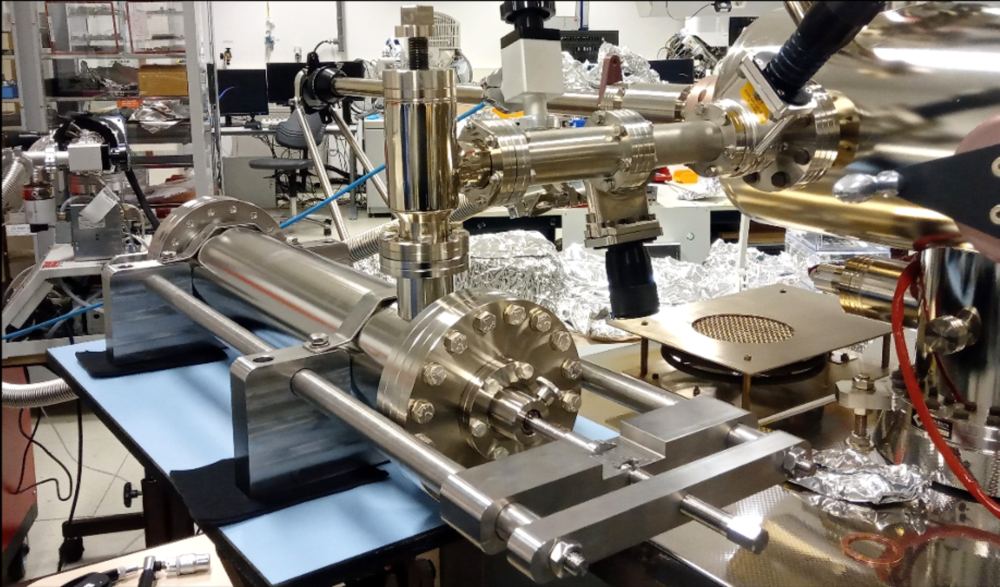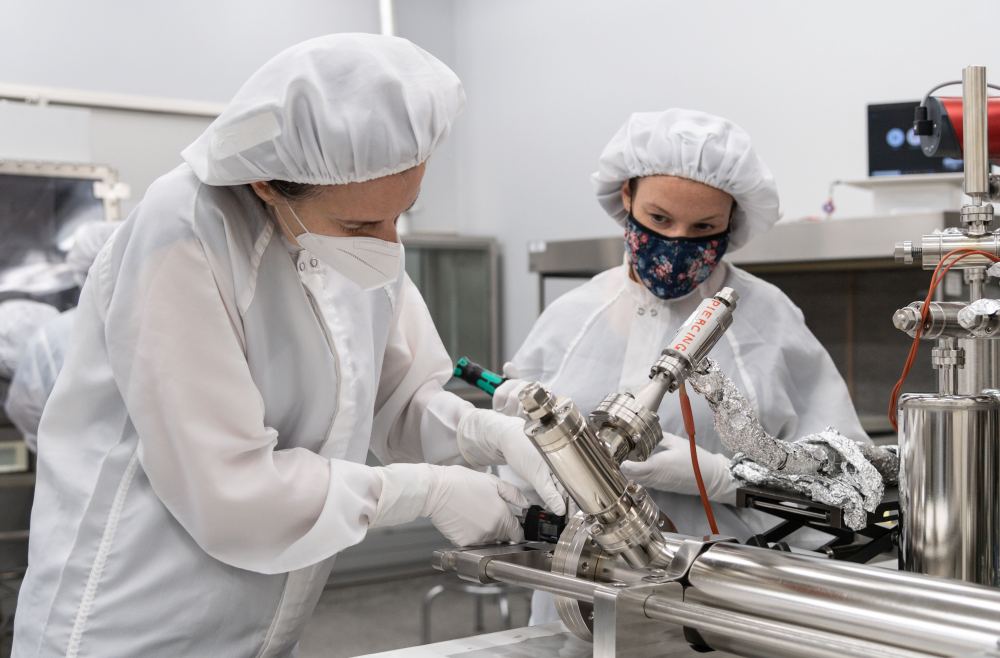NASA’s Apollo missions to the Moon brought back about 382 kilograms (842 pounds) of samples, including rocks, rock cores, rock, pebbles, sand, and dust. Scientists have studied those samples intently over the decades and have learned a lot. But they haven’t studied all of the samples.
In an impressive act of foresight, NASA left some of the samples unopened and in pristine condition. Why? Because they knew the technology used to study the samples would only improve over the decades.
Apollo 17 was NASA’s final Apollo mission and the last of six that made it to the Moon and back. The mission returned to Earth with its samples just over 50 years ago. The three astronauts on that mission were Gene Cernan, Ronald Evans, and Harrison Schmitt. Schmitt was a geologist and the only scientist ever to visit the Moon. The crew collected about 115 kg (254 lb) of lunar samples, the largest payload collected by any Apollo Mission.

Apollo 17 landed in the Taurus-Littrow Valley on the eastern edge of Mare Serenitatis. The mission had two main geological objectives: to obtain samples of ancient rocks from the lunar highlands and to look for evidence of young volcanic activity on the valley floor.
The astronauts put the samples in Special Environmental Sample Containers. The containers have seals to protect the enclosed sample from atmospheric gases prior to being opened in a vacuum chamber at the Johnson Space Center.

Fifty years have passed since Apollo 17 returned to Earth, and NASA has decided that now is the time to open the last remaining unopened lunar sample from the Apollo Program. The Apollo Next Generation Sample Analysis Program (ANGSA) will unseal the sample. ANGSA is a team of scientists whose goal is to “… maximize the science derived from samples returned by the Apollo Program in preparation for future lunar missions anticipated in the 2020s and beyond.”
“Understanding the geologic history and evolution of the Moon samples at the Apollo landing sites will help us prepare for the types of samples that may be encountered during Artemis,” said Thomas Zurbuchen, associate administrator of NASA’s Science Mission Directorate in Washington. “Artemis aims to bring back cold and sealed samples from near the lunar South Pole. This is an exciting learning opportunity to understand the tools needed for collecting and transporting these samples, for analyzing them, and for storing them on Earth for future generations of scientists.”
When the Apollo missions collected their samples in the 1970s, the technology available to study them was formidable. But in the intervening years, technological advances have propelled that technology to new levels. Scientists can now study these samples in ways that would’ve seemed like science fiction to researchers in the 1960s and 1970s.
“The agency knew science and technology would evolve and allow scientists to study the material in new ways to address new questions in the future,” said Lori Glaze, director of the Planetary Science Division at NASA Headquarters. “The ANGSA initiative was designed to examine these specially stored and sealed samples.”
Some of the scientists who will study these unopened Apollo samples weren’t even born when the samples were collected. Sadly, many of the people involved in the Apollo program have passed away and will never get to see some of the results of their epic missions and their wise decision to leave some samples for the future.
When the Apollo 17 crew collected the samples, they placed them in a two-chamber sample container called a double-drive tube. The unopened sample is called the ANGSA 73001 sample. The crew sealed it under vacuum on the Moon, and it’s been stored inside a protective outer vacuum tube in an atmosphere-controlled environment at Johnson ever since. NASA unsealed the other portion in 2019.

Jessica Barnes from the University of Arizona’s Lunar and Planetary Laboratory was one of the scientists given access to the unopened lunar samples in 2019. At the time, Barnes said, “Being able to study these previously unopened samples is like a whole new lunar sample return mission. Not only do we get to be a part of the history of opening these samples, but we also will be using this opportunity to study how curation practices, such as ambient versus cold storage, affect our ability to measure a lunar water signature. “It’s exciting because this has never been done before.”
“They realized that future technologies would allow us to do things that would have been impossible at the time and that people would come up with new questions, and it’s really exciting because we’re at that point in time now,” Barnes said in 2019.
One of the enduring questions in Solar System science right now concerns the source of Earth’s water. But to understand that, scientists have to look around the rest of the inner Solar System for clues. That’s because plate tectonics erased geological evidence from Earth’s earliest history. But on the Moon, there is no plate tectonics, and the ancient rocks are intact.
“To understand where water in the solar system came from, and particularly how it ended up on Earth, Mars, and in the asteroid belt, we have to consider the moon,” Barnes said in 2019. “Understanding how life on Earth began is intimately tied to the story of how water arrived here. Lunar samples are critical pieces in this puzzle because unlike Earth, where the oldest rocks have largely been erased by plate tectonics, the moon’s ancient rock record is still intact.”

We only discovered water on the Moon about a decade ago and haven’t gathered any lunar samples since then. So this unsealed sample could play a role in our quest to understand Earth’s water.
Scientists compare water from different parts of the Solar System with isotope ratios. The hydrogen in water molecules is in two isotopes: H1, also called protium, and H2, called deuterium. In a sample of water, there’ll be a ratio of these two stable isotopes of hydrogen. A third hydrogen isotope, called tritium, decays rapidly.
If two Solar System bodies have the same hydrogen isotope ratios in their water, it’s called isotope homogenization, and it suggests the water had the same source or history. Scientists have studied hydrogen isotope ratios on Earth and compared them to lunar isotope ratios and meteorite ratios. Understanding all these different waters is part of the effort to understand how our Solar System formed and evolved.
Other elements in lunar rock also have isotope ratios. They’re essential evidence in the Giant Impact Hypothesis, which says that the Moon formed from the debris from a collision between early Earth and a Mars-sized protoplanet named Theia. But the world of isotope ratios is complicated. Some isotopic evidence supports the Giant Impact Hypothesis; other isotopic evidence contradicts it.
Will this unopened Apollo sample bring any clarity?
The technology for studying samples has advanced a lot. One of the available devices did not exist when scientists first studied the Apollo samples. It’s called a Nano-SIMS, or Nano-Scale Ion Mass Spectrometer.
Nano-SIMS allows scientists to identify isotopes and “create nanoscale maps of elemental or isotopic distribution,” among other things. Scientists use Nano-SIMS to measure the content of all kinds of samples, from meteorites to ancient rocks to fine-grained dust from a comet.

Nano-SIMS is a powerful technology, and researchers will undoubtedly bring it to bear on this pristine sample. But we’re not there yet.
When the Apollo 17 astronauts collected the sample, conditions were very cold at the bottom of the tube. That means that any volatiles like water and carbon dioxide would have been frozen and should still be in the tube. One of the reasons this sample is of such great interest is that it came from the Moon’s mid-latitude regions, where NASA is sending the Artemis mission. So understanding these samples will help the Artemis mission prepare for their sampling efforts.
There’s probably not a lot of gas in the sealed sample. But if scientists can extract it carefully, the gas will still be full of clues. Modern mass spectrometry tools like Nano-SIMS are extremely sensitive and will be able to determine with great precision the mass of molecules in the gas and identify them accurately. Not only that, but Nano-SIMS needs only a tiny portion of the sample to do its work. That means that the sample can be portioned out to multiple researchers studying different aspects of lunar science.
Extracting the sample from its tube is a whole endeavour in itself. Scientists at Washington University in St. Louis developed special equipment called a manifold to extract and collect the gas in the tube. Another team of scientists at the ESA developed a unique tool to pierce the lunar sample container without letting any gas escape. This unique system was all developed entirely for this sample, and it’s undergone rigorous testing.

The team responsible for extracting the sample started their work on February 11th, 2021. The entire process will take months, and it started with opening the outer protective tube and collecting any gases. There were no surprises, as the team knew what it should contain in advance, and they found everything as expected. The outer tube contained no lunar gases, meaning that the inner tube’s seal was still intact and not leaking.

Credits: NASA/James Blair
On Feb. 23, the team began the next step in the complex process. Piercing the inner container and slowly gathering any lunar gases that are hopefully still inside will take weeks.
Once the gas is removed, the team from NASA’s Astromaterials Research and Exploration Science Division (ARES) will begin carefully removing the soil and rocks.

Credits: NASA/James Blair
NASA’s Ryan Zeigler is the Apollo sample curator. It’s his job to oversee the process of extracting the gas and rock. Zeigler’s job is to properly prepare, catalogue, and share the sample with others for research. And the excitement is building.
“A lot of people are getting excited,” said Zeigler.
More:
- Press Release: NASA Studies ‘New’ 50-Year-Old Lunar Sample to Prep for Return to Moon
- Wikipedia: Apollo 17
- Universe Today: NASA’s VIPER Rover Will Hunt for Water Near Nobile Crater at Moon’s South Pole
The post 50-Year-Old Lunar Samples are Opened up for the First Time appeared first on Universe Today.
No comments:
Post a Comment